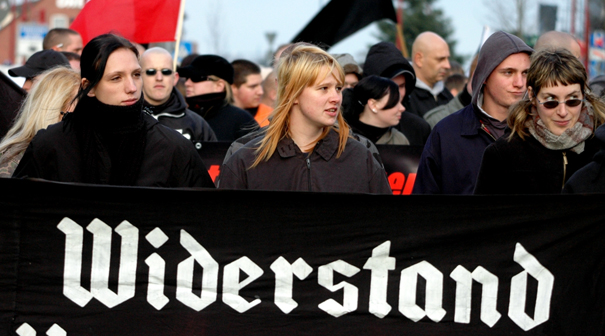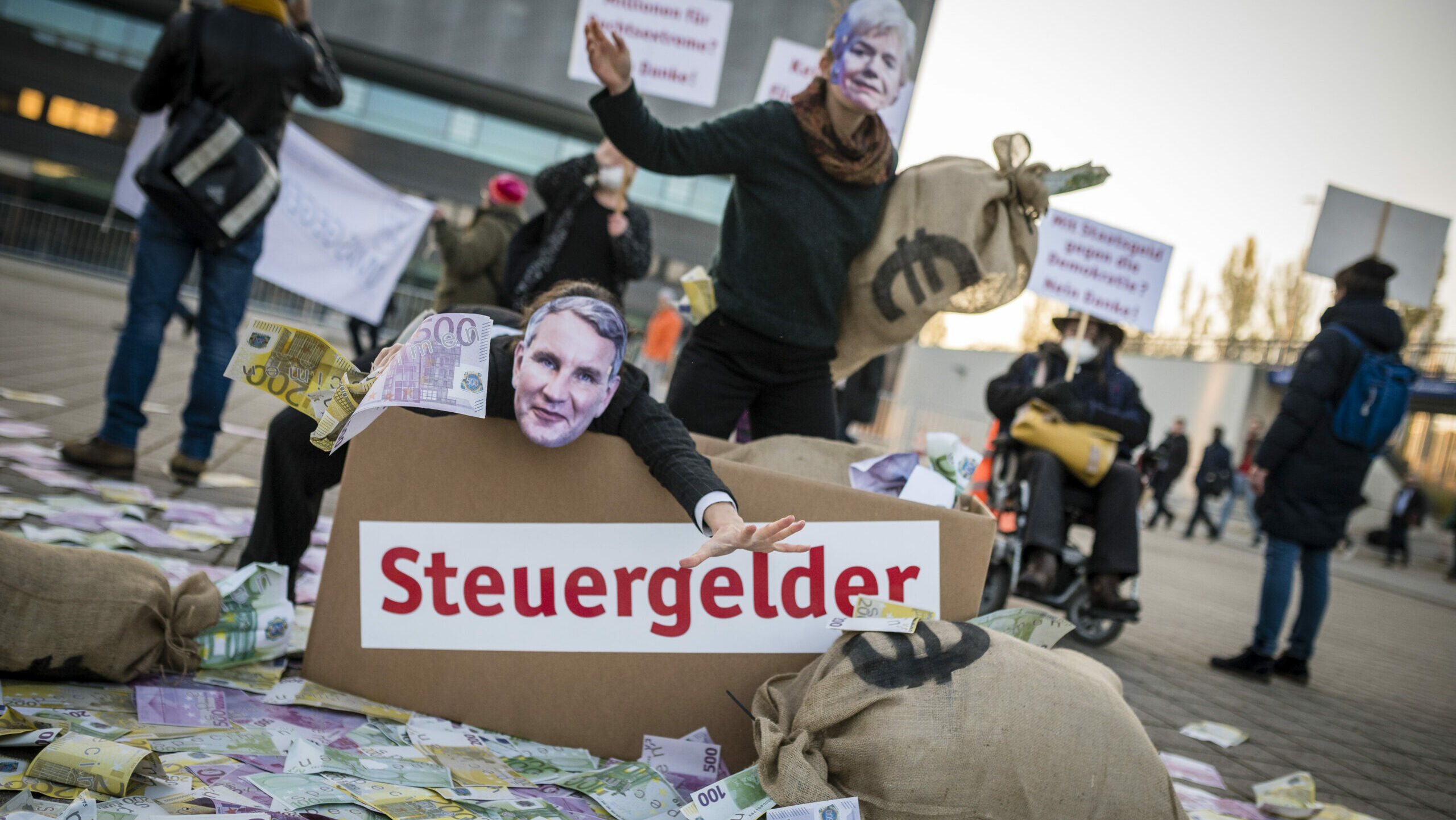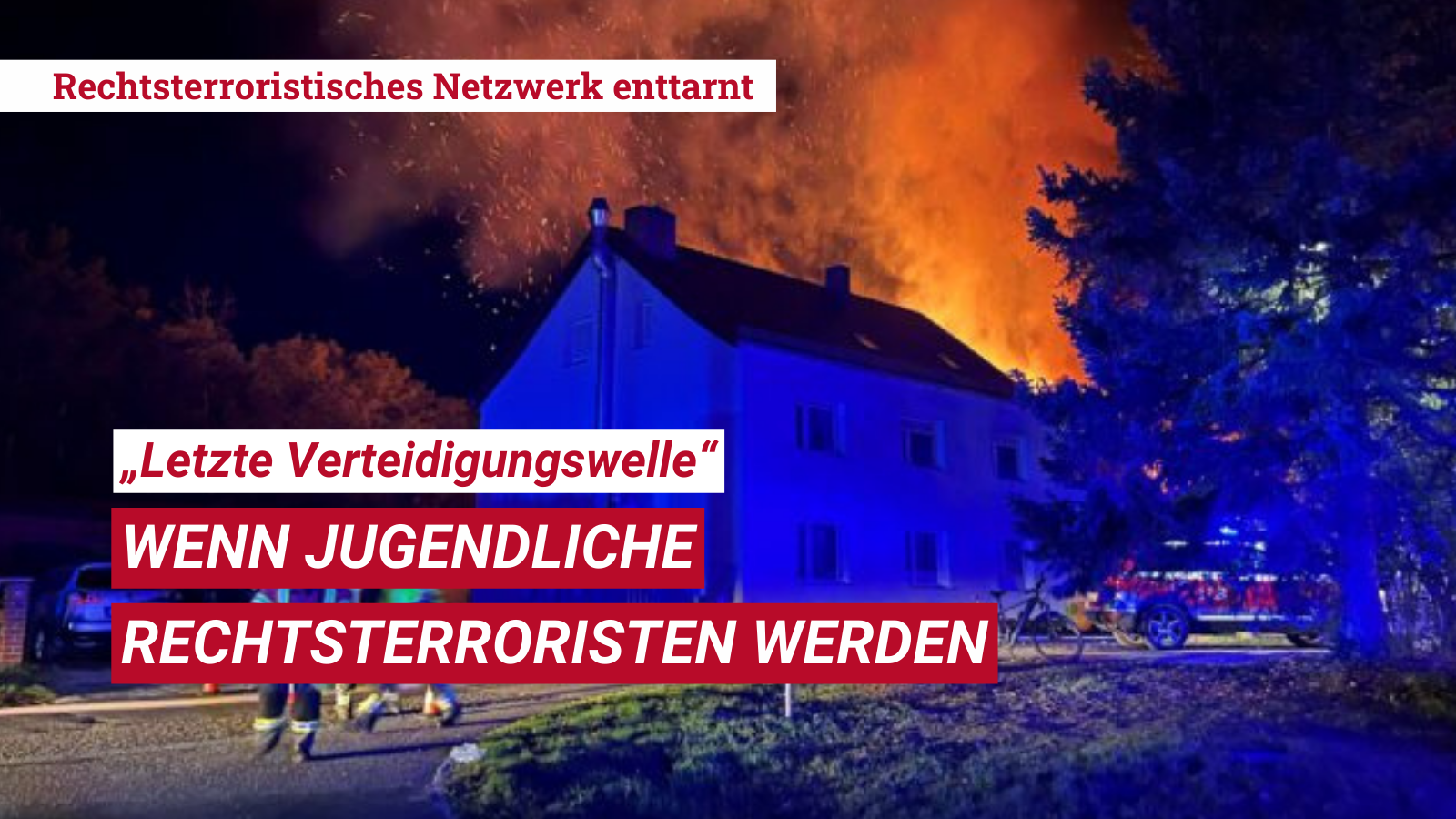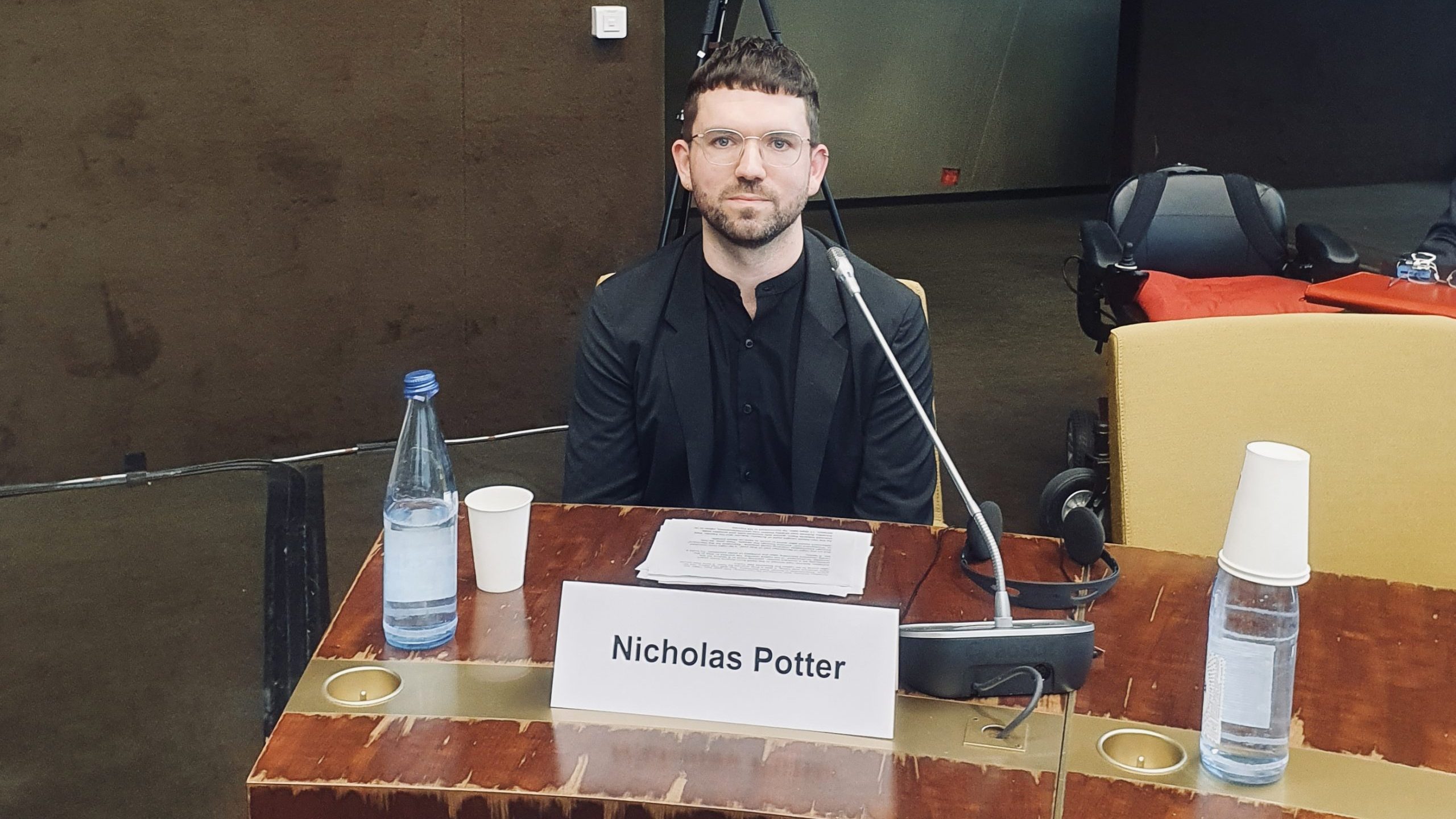On behalf of the Expert Center “Gender and right-wing extremism” of the Amadeu Antonio Foundation, Ulrich Overdieck analyzed the cognitive deficits in the perception of female right-wing terrorists by using the example of Beate Zschäpe.
Beate Zschäpe is (as known so far) one of only three members of the “National-Socialist Underground” (NSU). For the research Ulrich Overdieck has – among other things – attended some selected hearings in the continuing NSU-trial in Munich against Beate Zschäpe and four male supporters of the NSU. He observed the media coverage about the trial and evaluated the report which was produced by the committee of inquiry on the NSU (Bundestagsuntersuchungsausschuss “NSU”). These are the investigations, in which mistakes and defaults of the National Security Authorities should be elucidated.
During the project it had to deal basically with the question whether it had just been possible for Beate Zschäpe to take part in serious racist crimes, such as murders and attacks with explosives, because she was underestimated as a woman. The key issue in this context is about the consequences of cognitive deficits in the perception of female right-wing extremists; Cognitive deficits, not only on the part of National Security Authorities, but also on the part of civil society and even educators and social workers. Besides that the media coverage plays an important role in this case.
1. Context of NSU and History of right-wing terrorism and female right-wing terrorists
The NSU is closely connected with a series of racist murders. The victims are 9 small traders; 8 Turkish, one Greek migration background. A policewoman was killed by the NSU as well.
Furthermore two racially motivated attacks with explosives with a high number of injured people, and some bank robberies were committed by the NSU.
The police, at first, was not able to catch the offenders – 3 members of NSU from Jena/ Thuringia – who were sought because of right-wing offences and therefore abscond. They were hiding several years not far away but in the small towns Chemnitz and Zwickau in Saxony.
The police and the secret service were also not able to recognize the series of racist murders and the attacks with explosives as an act of right-wing terrorists. And certainly they did not relate the action with the 3 members of NSU. All racist murders were committed with the same weapon. And the police made an investigation against the families of the victims in all cases. From a racist perspective, the safety authority implied that the victims and their environment would be criminal themselves and were murdered in the context of competition fights.
Even though the police had no evidence for this assumption, they didn’t change their approach. The investigation of the crimes as racist crimes started only when a bank robbery of the NSU failed in November 2011. On that day Uwe Mundlos and Uwe Böhnhardt committed suicide to escape from an imminent arrest. During the investigation a number of proof and evidence were found and the enlightenment began. Besides that a video with a claim of responsibility for the murders was found; this video was spread by Beate Zschäpe to glorify the doings of NSU.
In contrast to the Safety Authority, the mass-media and the majority society, the families of the victims, again and again, stressed that according to their views a racial motivation of the offender was possible. The picture shows a demonstration in April 2006 in Kassel/Hessen, where 2.000 people – mostly members of migrant-groups from all over Germany – came together to remember the 9th victim of NSU, Halit Yozgat. The ones who did not listen are not only the Office for the Protection of the Constitution (Verfassungsschutz, that’s the name of the Secret Service in Germany) and the police, but also the media and the civil society.
After the discovery, respectively the self-revelation of the NSU, it was conceived as something totally new, that there exists right-wing terrorism in Germany. It had remained in oblivion that there was another murder series of several right-wing terrorists in West-Germany in the years 1980-1982 up to 20 dead.
Since in the eyes of many people right-wing extremists are all-male, many people were also irritated because of the fact that among the three members of NSU there was a woman. And this woman was the only one who remained from the core group of the NSU. So she was the focus of the public, the media and the police investigations.
Although there may be some limited knowledge about precursors of the right-wing terrorism of the NSU in the society, almost no one knows something about female right-wing terrorists in West-Germany. In the brochure we tried to renew the knowledge. Let me say just one thing: even before Beate Zschäpe, there were women who were involved into right-wing terror, bank robberies, explosive and fire bombings and paramilitary exercises.
2. General results of the participation of women (NSU/ environment of NSU)
Beate Zschäpe is – as known so far – the only female member of NSU, but there were some other female allies. As a result, it was possible for the NSU, its environment and its allies to commit such serious criminal acts for so many years because of the underrating of the role of women in the right-wing terrorism by the Safety Authority. Generally, the dangerousness of the right-wing scene was underrated – but especially the role of women who were involved in it.
Based on the current findings, female right-wings participate in a significant manner in the NSU and also in its environment and as the group of allies. And last but not least the stereotype of the “peaceful and non-political” women served the three NSU members as being perceived as “bourgeois facade” to camouflage the very terrorist activities.
The quantity of women in the environment of the NSU and the groups of allies is approximately 20%. That is the result of the “Antifaschistische Presserarchiv/ Apabiz” research which is based on some information from the Investigative Authority over 100 people.
The quality of the aid from the female right-wing people (often functionaries) was to accommodate Beate Zschäpe with identification documents, train tickets and health insurance cards. That gave her the possibility to change identities, whenever it was necessary. The female allies established an important frame for the life in illegality.
Plausible explanations were conceived; for example one of the female allies temporarily left her child so that Beate Zschäpe and one of the men could present themselves as a couple – and create the impression of normality and harmlessness. The female supporters contributed significantly to protect the NSU for many years against investigative authorities. The women who were the supporters have not been charged yet – only two are considered as suspects.
By the way one of the two women (Mandy S.) declared in the hearing of witnesses just a few weeks ago on the court in Munich that women in the right-wing scene were generally only in the role of follower. But there are a lot of statements of other witnesses and clear evidence that Mandy S. played an important role in the scene, and her status was recognized by the male as well. The description of women’s role in the right-wing scene possibly has influence on the degree of penalty – for the main defendant Beate Zschäpe.
Beate Zschäpe tried a lot to abide the facade of a normal life. She was helped by another important female supporter, Susann E., and probably her child. She kept good relationships within the neighborhood. The former neighbors characterize her as being social and unobtrusive. Beate Zschäpe obviously knows how to use the stereotype of “peaceful and apolitical” women to achieve the most effective deception. According to the prosecution, the goal was to disguise the flats and the action center of the NSU in the illegality.
3. Analysis of the proceedings
The Federal Prosecutor General (Generalbundesanwalt, GBA) brought the heaviest possible accusations against Beate Zschäpe. The Munich higher regional court (Oberlandesgericht München, OLG) permitted this prosecution. That means Beate Zschäpe possibly can get a lifelong imprisonment or even beyond preventive custody – the maximum penalty. The indictment describes Beate Zschäpe as one of three totally equal partners of NSU. In addition to the camouflage of the group, she helped to provide weapons and identity documents. She was responsible for the logistics and money management of the bank robberies. Moreover she was accused of complicity in the 10 murders of the terrorist group.
Legally she can be prosecuted for the murders, even when there is no evidence that she herself shot or was at the crime scene. (As far as it is known, she was not at any crime scene.) But normal interpretation of law in Germany allows charging her as an accessory (Mittäterin) if she wanted the doings “as hers” and therefore supported the success of the doings. In this case the result is the same that she would be sentenced like a murderer.
Furthermore Zschäpe is accused of malicious arson of the house in Zwickau where the three members of NSU lived in. She took the chance of the possible death of several people. She obviously put the fire to destroy the evidence. So at the moment it seems that the judge and the Federal Prosecutor General (GBA) have not underrated Zschäpe in the proceeding just because she is a woman.
A notice: after the suicide of her 2 accomplices, Zschäpe put fire to the house, sent a confession DVD, informed the families of her accomplices about their death and travelled through Germany 4 days on her own until she turned herself in to the police.
Till today, we do not know how Zschäpe came to know about the death of her accomplices. And we also do not know what she did during her 4 days of escape. Theoretically she must have tried to contact some of the supporters, or maybe with some still unknown accomplices. On the media there is astonishingly no concern about this period of time.
Also the higher regional court in Munich (OLG) and the President of German Federal Office of Criminal Investigation (Bundeskriminalamt, BKA – like the FBI in the USA) made a commitment already before the beginning of the process against Zschäpe that the NSU, after the dead of Mundlos and Böhnhardt and the imprisonment of Zschäpe, stopped existing. Even if the assumptions are accurate in this assessment, one question is to be asked that whether the addressed clarification gap – 4 Days unobserved – in a right-wing man would not trigger a serious concern both within the security organs as well as in the media. After all according to the indictment Zschäpe is one of the heads of a right-wing terror-group.
In the process it became obvious how good the disguise worked out, also in contact with the police. Some witnesses in the process illustrated the coolness of Zschäpe. In the end of 2006 directly above the flat of the NSU members was water damage in an empty flat. The police tried to find out who caused the water damage, and as a routine Beate Zschäpe as a neighbor/ witness was questioned.
She involved herself in terrible contradictions. On one hand she claimed not to live in that flat, but on the other hand she talked about the flat several times as her flat. In the building she was also known by a different name than in the document she submitted. But despite these contradictions, she could leave the police station because she managed to present all that as a big misunderstanding. The possibility to uncover NSU went missing.
It may have played a key role in this situation that Beate Zschäpe was noticed as a German without a migration background. Just imagine, instead of Beate Zschäpe in that situation the policeman had come across with a young man with an – real or expected – migration background. I don´t think that the police would have trusted him if he had made such confusing declarations about his identity and living situation.
4. Analysis of media coverage
More critical than judges and prosecutors are the media publications. This brings us to the fourth and penultimate point; the media analysis to reporting on the process. When Beate Zschäpe abruptly became the most famous female right-wing extremist of Germany in November 2011, some of the most high-circulation media presented her as a non-political person. They discussed about her love/ sex life, and characterized her ignorant and hasty as a follower. Only a few journalists made a research about her past in the organized right-wing extremist scene in Thuringia. It got better even after the “Research Network Women and Far Right” complained about it in an open letter. So that was the situation in the end of 2011.
In the beginning of the process in May 2013 in Munich only legal formalities were handled, so as a result the mass media focused on the outlook, clothing, haircut, mimicry and gesture of the closemouthed Beate Zschäpe. The clothing of the male defendants was less or not at all reported.
It is clear that since the discovery of the NSU there is an expectation in the media that Zschäpe is going to show penitence and empathy with the victims. In the beginning of the process this was articulated several times. The reason for that can be explained by gender role expectations. These expectations are only focused on Zschäpe, but, for example, not on the two most important male supporters, who could have given a lot of information in the process, too. Both of these men are expected to be more committed to their political attitude than Zschäpe or at least to have a lower sense of empathy or social skills.
It is possible to say that media in the case of Beate Zschäpe, especially when they had to react spontaneously, unconsciously use gender stereotypes. I would like to give an example that in the media coverage about the NSU-process in June 2013 after the first statement of the conniver of Carsten S. there was a general agreement that Zschäpe is partly exonerated. So what happened? Carsten S. surprisingly told about a conversation between him, Uwe Mundlos and Uwe Böhnhardt.
In this conversation both of them made hints about an attack with explosives in Nuremberg. When Beate Zschäpe came along, Mundlos and Böhnhardt made “Psst!” to interrupt the conversation. According to the interpretations of the media, this meant that Zschäpe was generally allowed to know little and she knew little. But this interruption of the conversation has no judicial cause to exonerate Zschäpe because it is not obvious why the interruption took place.
It is not implausible that Mundlos and Böhnhardt worried about Zschäpe’s reaction. The supporter Carsten S. was young and not well-known to them so that Mundlos and Böhnhardt maybe interrupted the conversation to cover their own bragging. I don´t think that if Beate Zschäpe were a male, media would, just because of this single situation, imply her to be uninformed. This situation would raise the suspicion that she is the leader of the group whose control must be respected.
If you interpret the situation like media did, the interpretation is influenced by pictures of her as a harmless woman. The described situation does not provide that here.
5. Parliamentary committee of inquiry on the NSU & handling of female right-wing extremists
An example shows the deficits in the policework, that were lay open by the Parliamentary committee of inquiry. In the region Nuremberg for a short time in 2007 the police dealt with the question that the murders might be racially motivated. A dragnet investigation was forced.
But the police missed the chance of the already mentioned NSU supporter Mandy S. to get on the track. The protection of the constitution of Bavaria/ Secret Service of Bavaria gave a list with the names of all right-wing extremists in the area of Nuremberg to the Police. But the Police concretized their investigation, and suspended, among others, all female names from their list. So they suspended all females from further check-up and by this they suspended also Mandy S. who was on the list too. That means that they missed a chance to cover up the NSU structure in 2007. The police just did not profile the right-wing women extremists to make the investigation easier. And because they did not think, that right-wing women extremists got to do with this murders.
In the run up to the process, we, by the way, gave a recommendation to the Parliamentary committee of inquiry: From our point of view in the education and advanced training for police, justice and secret service have to convey a gender perspective in the analysis and cognition of right-wing extremism. The trainings for police officers should enable them to perceive and document the complicity of women.
Also the monitoring of right-wing criminal and violent acts and of right-wing structures should be taught with a gender perspective. In our opinion these simple and quickly implemented measures would be more effective after a first step to anchor the subject of right-wing and gender as a field of action in the security authorities.
But these measures didn’t find their way into the final report – in this words.
Ulrich Overdieck studied Gender Studies at the Humboldt University of Berlin. The topic of his final thesis was “right-wing extremism and masculinity”. During his studies and after graduation he has worked for the Club of Democratic Culture (Verein für Demokratische Kultur) in Berlin. His main task there has been not only the right-wing extremism, but also some questions with the focus on gender perspectives. On behalf of the Expert Center “Gender and right-wing extremism” of the “Amadeu-Antonio-Foundation”, he has analyzed the cognitive deficits in the perception of female right-wing terrorists by using the example of Beate Zschäpe.



